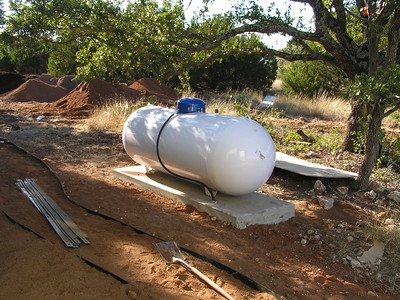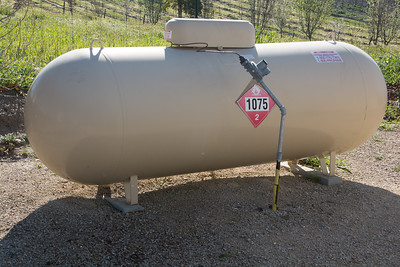
To determine if a 500-gallon propane tank is the right size for your home, you should consider the following factors:
- Home size and insulation: The size and insulation of your home will greatly impact your propane consumption. A smaller, well-insulated home will require less energy to heat, making a 500-gallon propane tank potentially suitable. Conversely, larger homes or those with poor insulation may require a larger tank or more frequent refills.
- Climate: The climate of your region can also affect your propane usage. If you live in an area with colder winters or longer heating seasons, your propane consumption will likely be higher, which could necessitate a larger tank or more frequent refills.
- Appliances: Consider the number and type of propane-powered appliances you have in your home. If you use propane for heating, water heating, cooking, and other appliances, a 500-gallon tank may be adequate. However, if your propane usage is significantly higher due to many appliances, you may need a larger tank.
- Usage patterns: Analyze your household’s propane usage patterns. If you only use propane for heating during the winter months, a 500-gallon tank may be sufficient. On the other hand, if you use propane year-round for multiple applications, you might need a larger tank.
- Budget: The cost of purchasing and installing a propane tank can vary depending on the size and location. Ensure that a 500-gallon tank fits your budget, including the initial investment, installation, and ongoing maintenance costs.
- Local regulations and codes: Before installing a propane tank, check your local regulations and building codes to ensure you comply with any size or placement restrictions.
It is highly recommended that you consult with a local propane supplier or a heating professional to help you determine the appropriate propane tank size for your home. They can perform a detailed analysis of your home’s energy needs and recommend the right tank size based on your specific situation.
A 500-gallon propane tank can indeed be a suitable option for heating a smaller home or multiple appliances. Propane is an efficient and cost-effective fuel source that provides clean and reliable energy. Here are some advantages of using a 500-gallon propane tank:
- Reduced number of fill-ups: A larger tank, like a 500-gallon one, can store more propane, allowing you to go longer between refills. This can be especially beneficial during colder months when heating demands are higher.
- Versatility: Propane can be used for various applications, such as home heating, water heating, cooking, and even for outdoor appliances like grills and fire pits. A 500-gallon tank can accommodate multiple appliances, providing a consistent energy source.
- Emergency preparedness: A larger propane tank provides an added level of security during power outages or other emergencies, as propane can be stored safely for long periods and is readily available to fuel essential appliances when needed.
- Energy efficiency: Propane is an efficient fuel source that burns cleaner than many other fossil fuels. By using a 500-gallon propane tank, you can reduce your overall energy consumption and contribute to a greener environment.
- Cost-effective: Depending on your location and fuel prices, propane can be more cost-effective than other heating options like electric or oil. Investing in a larger propane tank may result in long-term savings on your energy bills.
However, it’s essential to consider your specific needs and the size of your home when selecting the right propane tank size. You should consult with a local propane supplier or a heating professional to ensure a 500-gallon propane tank is the best option for your home and appliances. They can also help you with proper tank installation and maintenance.
Tips for Making the ight Decision
When deciding on the right propane tank size for your home, it’s essential to make an informed decision based on your needs and future plans. Here are some tips to help you make the right choice:
Consulting with a propane supplier: Reach out to a local propane supplier or a heating professional to get advice on the appropriate propane tank size. They can assess your home’s size, insulation, and energy needs and provide guidance based on your specific situation. A professional can also inform you about local regulations and installation requirements.
Analyzing your past propane usage: Review your past propane bills to get a better understanding of your usage patterns. This can help you estimate how much propane you might need in the future and determine the right tank size. If your propane usage has been relatively stable, it can be a useful reference point. However, if you have experienced significant fluctuations or expect changes in your usage, you might need to consider other factors as well.
Considering future plans and potential changes in usage: Think about any potential changes in your household or lifestyle that could impact your propane usage. For example, if you plan to add more propane-powered appliances, upgrade your home’s insulation, or expand your living space, these changes could affect your propane needs. Additionally, consider any foreseeable changes in your local climate, which could impact heating demands.
Other aspects to consider:
- Cost: Consider the cost of purchasing, installing, and maintaining a propane tank. Larger tanks might have a higher upfront cost but could save you money in the long run by reducing the frequency of refills.
- Space: Evaluate the available space on your property for installing a propane tank. You need to ensure that there is enough room for the tank itself and that it meets any local setback requirements.
- Refill frequency: Consider how often you are willing to have your propane tank refilled. Larger tanks will require fewer refills, but this should be balanced against the cost and space requirements.
By considering all these factors and consulting with professionals, you can make an informed decision on the right propane tank size for your home.
Factors to Consider When Choosing a Propane Tank Size for Your Home
When choosing a propane tank size, there are several factors to consider, including the size of your home and its energy efficiency. Here’s a more detailed breakdown of these factors:
A. Size of your home:
The size of your home will have a significant impact on your propane consumption and the appropriate tank size.
- Square footage: Larger homes generally require more energy to heat, so if you have a larger home, you may need a bigger propane tank. Conversely, smaller homes may need smaller tanks or can use larger tanks for longer periods between refills. Consider your home’s square footage when determining the right propane tank size.
- Energy efficiency: The energy efficiency of your home also plays a role in determining the appropriate propane tank size. Energy-efficient homes have better insulation, windows, and doors, which help retain heat and reduce energy consumption.
B. Other factors to consider:
- Climate: The climate in your region will affect your propane usage, especially during the heating season. Colder climates with longer winters may require larger propane tanks or more frequent refills.
- Appliances: Evaluate the number and type of propane-powered appliances you have in your home, such as heating systems, water heaters, cooktops, and fireplaces. The more appliances you have, the higher your propane consumption will be, which may necessitate a larger tank.
- Usage patterns: Consider how you use propane throughout the year. If you rely on propane mainly for heating during winter months, you may need a different tank size than if you use propane year-round for multiple purposes.
- Future plans: Take into account any future changes to your household or lifestyle, such as adding new propane appliances, improving your home’s energy efficiency, or expanding your living space. These changes can impact your propane needs and the right tank size.
- Budget and costs: Consider the costs of purchasing, installing, and maintaining a propane tank. Ensure the chosen tank size fits within your budget and provides a balance between upfront costs and long-term savings.
- Local regulations: Check your local regulations and building codes for any restrictions on propane tank size and placement.
To make the best decision, consult with a local propane supplier or heating professional who can help you assess your home’s energy needs and recommend the right propane tank size based on your specific situation.
Potential Drawbacks of a 500-Gallon Propane Tank
While this size propane tank can be beneficial for some homeowners, there are potential drawbacks to consider:
- Space requirements: A 500-gallon propane tank requires a considerable amount of space for installation. Depending on the layout and size of your property, you may have difficulty finding an appropriate location that meets local setback requirements and safety guidelines. In addition, if you have a smaller property, a large tank might be visually unappealing or take up valuable outdoor space.
- Not suitable for smaller homes with lower propane usage: A 500-gallon tank may not be the best choice for smaller homes with low propane consumption. In such cases, a smaller tank may be more appropriate and cost-effective. An oversized tank for your needs may result in propane sitting unused for extended periods, which can lead to fuel degradation or increased maintenance requirements.
- Higher initial cost compared to smaller tanks: The upfront cost of purchasing and installing a 500-gallon propane tank is typically higher than that of smaller tanks. If your propane usage is low, it may take a long time to recoup the additional expense through reduced refill frequency.
- Maintenance: A larger tank may require more maintenance and regular inspections to ensure its safe operation. This could lead to additional costs and time spent on upkeep.
- Environmental impact: While propane is generally considered an environmentally friendly fuel, larger tanks have a larger potential for leaks or spills. Ensure your tank is regularly inspected and maintained to minimize any environmental risks.
Before deciding on a 500-gallon propane tank, it’s essential to assess your specific needs and consult with a local propane supplier or heating professional. They can help you determine the most appropriate tank size for your home and provide guidance on installation and maintenance requirements.
Your Alternatives If This Doesn’t Fit Your Requirement
When considering alternatives to a 500-gallon propane tank, you can explore smaller or larger tanks depending on your needs. Here is a brief overview of some alternatives:
Smaller tanks (e.g., 100-gallon, 250-gallon): Smaller tanks are suitable for homes with lower propane usage or limited space for tank installation. They can be more cost-effective for homes with fewer propane appliances or smaller heating needs. However, smaller tanks require more frequent refills, which could be inconvenient, especially during colder months.
Larger tanks (e.g., 1,000-gallon): Larger tanks are ideal for homes with high propane usage, larger square footage, or those in colder climates. They can store more propane, reducing the frequency of refills and potentially lowering long-term fuel costs. However, larger tanks come with higher upfront costs and require more space for installation.
Consult with a local propane supplier or heating professional to help you determine the best tank size for your home based on your specific needs and situation. They can provide valuable advice and guidance on choosing the most appropriate propane tank for your home.

Mike is an experienced propane technician with over 15 years of professional experience in the field. He has dedicated his career to helping customers with their propane needs, from installation to maintenance and repair. Together with Jeremy, he co-founded this website to provide useful information and guidance to customers seeking reliable propane services.



